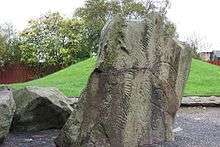Brandsbutt Stone
The Brandsbutt Stone is a class I Pictish symbol stone in Inverurie, Aberdeenshire, Scotland.
| The Brandsbutt Stone | |
|---|---|
 The Brandsbutt Stone, showing detail of ogham script | |
| Material | Whinstone |
| Height | 1.07 metres (3.5 ft) |
| Writing | Ogham script: irataddoarens |
| Symbols |
|
| Present location | Inverurie, Aberdeenshire, Scotland |
| Coordinates | 57.2916°N 2.4000°W |
| Classification | Class I incised stone |
| Culture | Picto-Scottish |
Description
A large block of whinstone, 1.07 metres (3.5 ft) high, 1.27 metres (4.2 ft) wide and 0.91 metres (3.0 ft) deep, the stone had been broken up and used in building a dry stone wall before 1866.[1] The stone, now reassembled, bears two incised Pictish symbols, a crescent and v-rod and a serpent and z-rod, and an inscription in Ogham, IRATADDOARENS.[2] The carvings of the Brandsbutt Stone are dated to around AD 600.[3] It is a scheduled monument.[4]
Inscription

The inscription borne by the Brandsbutt Stone, IRATADDOARENS, has been described by Katherine Forsyth as "utterly baffling".[5] However, a handful of interpretations have been offered.[5][2]
The inscription might conserve a personal name Ethernan, corresponding to English Adrian.[2]
The ira- may be a Pictish verb cognate with Breton irha meaning "he lies".[5]
References
- Fraser, Iain (2008), The Pictish Symbol Stones of Scotland, Edinburgh: Royal Commission on the Ancient and Historic Monuments of Scotland, pp. 62–63
- "Brandsbutt Symbol Stone - Historic Environment Scotland". Retrieved 5 February 2018.
- Dating of the Brandsbutt Stone
- Historic Environment Scotland. "Brandsbutt Stone, symbol stone (SM90039)". Retrieved 13 March 2019.
- Forsyth, Katherine (1997). Language in Pictland – the case against 'non-Indo-European Pictish' (PDF). De Keltiche Draak. p. 36. ISBN 9789080278554. Retrieved 20 August 2018.
External links
- Entry in Canmore database